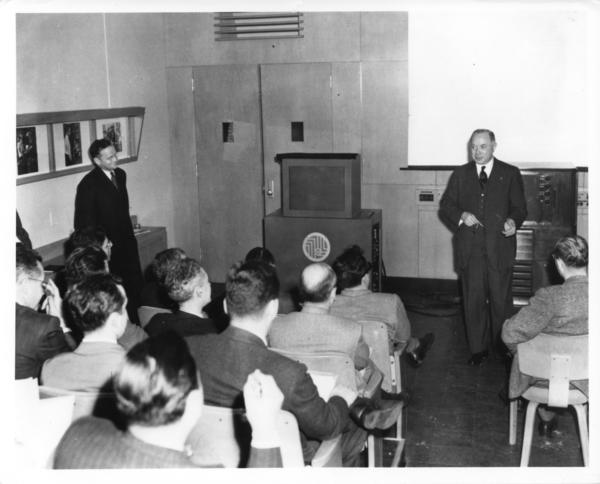The David Sarnoff Library (DSL) opened fifty years ago today adjacent to the library of the Radio Corporation of America’s David Sarnoff Research Center in Princeton New Jersey. In the early 1960s, Sarnoff, RCA’s iconic leader of more than three decades, had begun thinking about his legacy. Inspired by the Roosevelt and Truman Presidential Libraries, Sarnoff decided to open a library in the research laboratory that bore his name. He intended this library to house his private papers and focus on his contributions to the communications and electronics industries.
The David Sarnoff Collection (as it was then known) opened on September 28, 1967. In the years after Sarnoff’s death in 1971, the collection continued to develop and grow. Most notably, the DSL’s last executive director, Dr. Alexander Magoun, reached out to RCA’s executives, scientists, and engineers, acquiring their papers and vastly expanding the DSL’s scope.
RCA, of course, did not survive. Subsequent successor organizations took over management of the Research Center, but kept the DSL collections intact. The Sarnoff Corporation even invested new resources in the library, hiring historian of technology Magoun, first as curator in 1998 and then as the executive director in 2000, and supporting his collection development initiatives. The onset of the Great Recession, however, led to the Sarnoff Corporation’s decision to shutter the DSL. Magoun found homes for the DSL’s collections: the museum objects went to The College of New Jersey. But the enormous library collections—about 3,000 boxes worth of records, publications, photographs, film, digital files, and more—were too large to attract a credible commitment from any New Jersey repository. That is when Magoun contacted the Hagley Library.
Hagley Library was an ideal fit for the David Sarnoff Library. Our mission is to preserve and make accessible research collections describing the experience of American enterprise and innovation. Moreover, Hagley already held several large collections of RCA material, including records from RCA Victor Company, which had operated plants in Camden, NJ. We had the space and staffing to store and make the DSL collections available. What we lacked were enough staff to dedicate themselves entirely to a preservation project that would take several years to complete. Although the DSL collections had been accessible to researchers in Princeton, the DSL staff had little time to formally arrange and describe the collection according to professional best practices. A lot of the description, scope, and history of the collections resided primarily in Alex Magoun’s memory.

of all-electronic color television in October 1946.
Thanks to a generous grant from the Council on Library and Information Resources (CLIR) funded by the Andrew W. Mellon Foundation, Hagley was able to hire two project staff members, Daniel Michelson and Kenneth Cleary. Supporting them were a number of graduate assistants and interns, mostly from the History Department of the University of Delaware. Despite these many hands, significant numbers of the Hagley Library staff were involved in supervision, conservation, digitization, cataloging, publishing online finding aids, and the myriad tasks that go into a large processing project.
After three years of processing, preserving, and cataloging, the David Sarnoff Library’s collections, are now fully available to the public, described in twenty finding aids and including more than 5,000 pamphlets in Published Collections and 700 digitized items available through the Hagley Digital Archives. The collection includes thousands of linear feet of documents, reports, photographs, films, and publications detailing the rise and fall of the RCA Corporation and of Sarnoff, its longtime leader.
Hagley is proud of its work to preserve this collection documenting an iconic and innovative American business and the man who led that business for multiple decades. At 50, the David Sarnoff Library wears its age lightly: it includes materials donated by more than one hundred individuals and companies resulting in tens of thousands of preserved documents, reports, and publications, as well as photographs, films, and other records. We invite the public to explore the incredible stories of American business and innovation to be found in these records on our website and at the library.
Erik Rau is Director, Library Services, at Hagley
